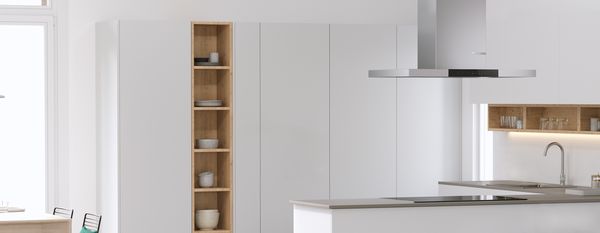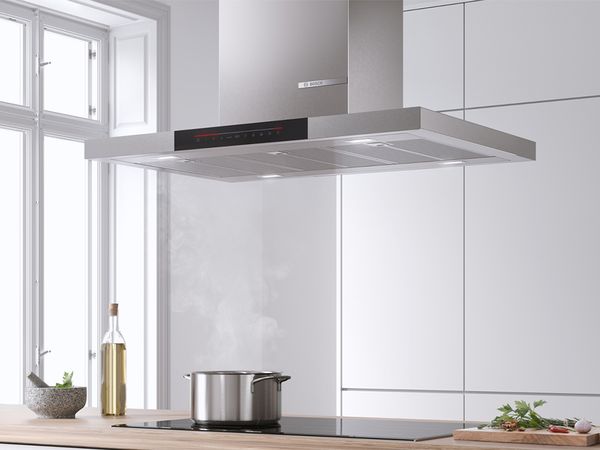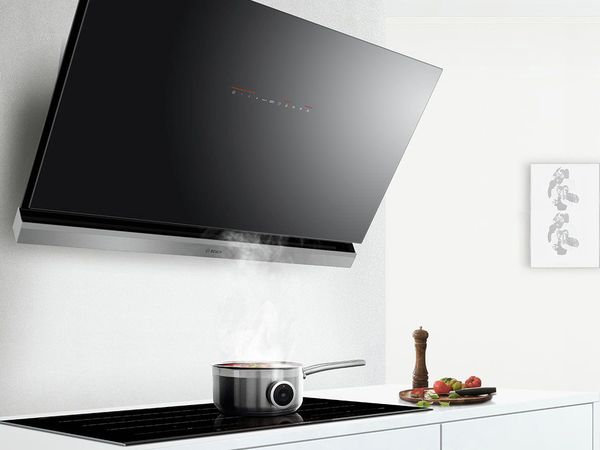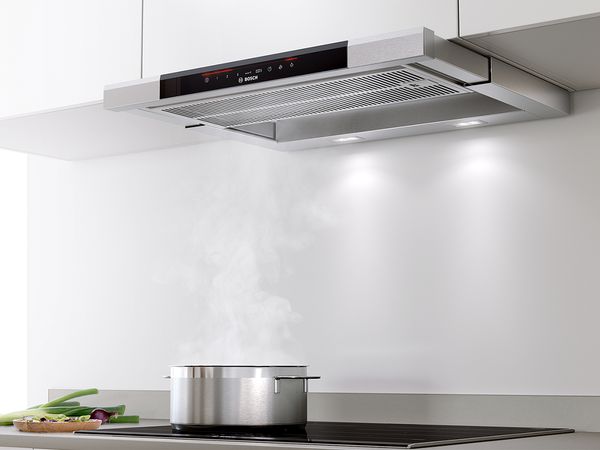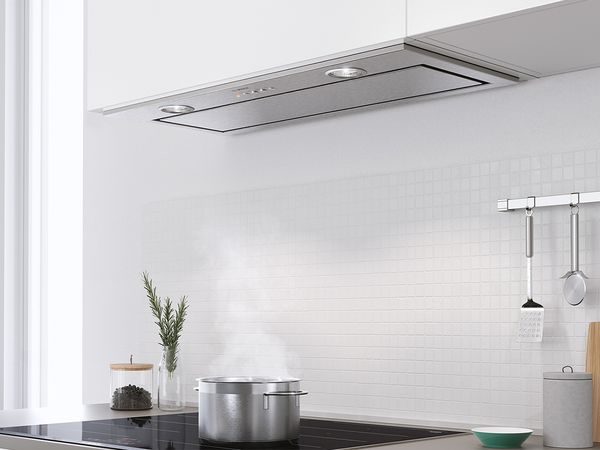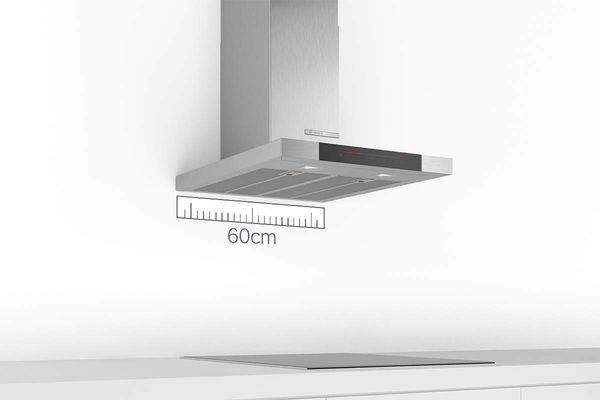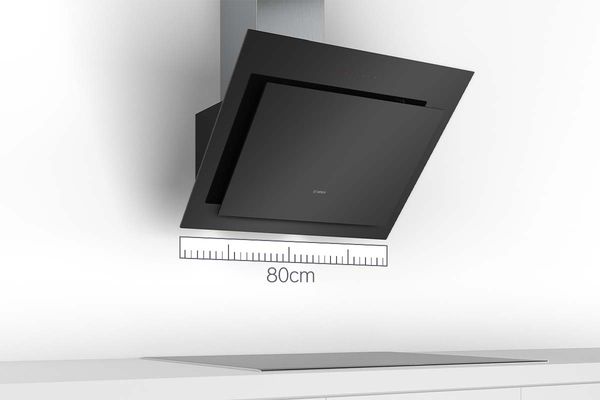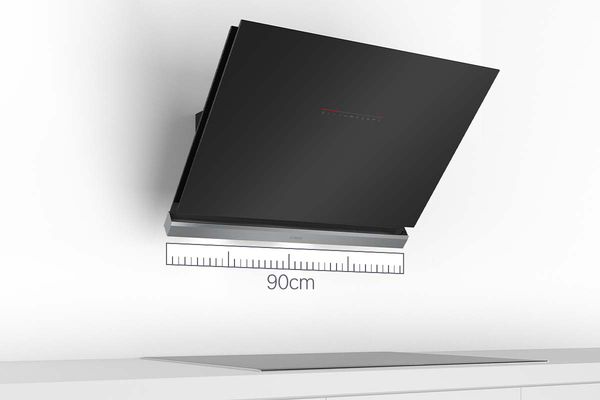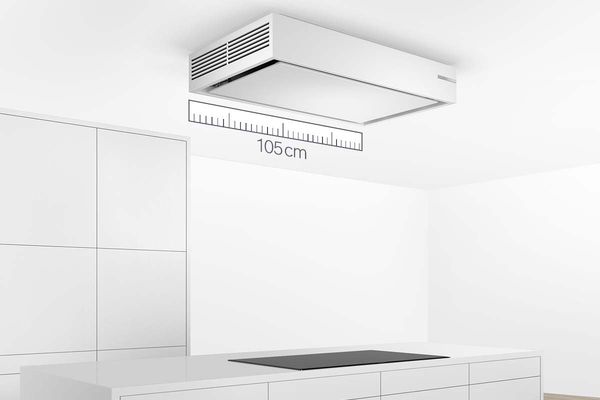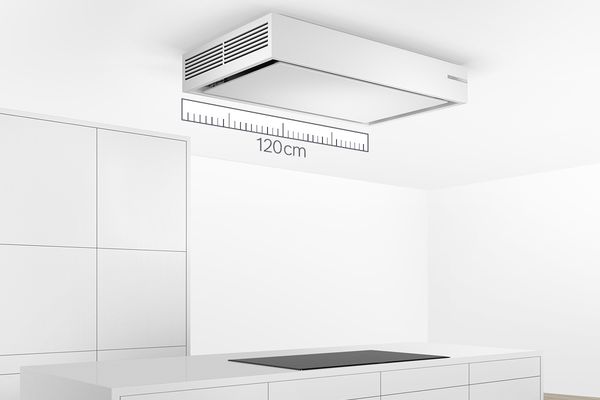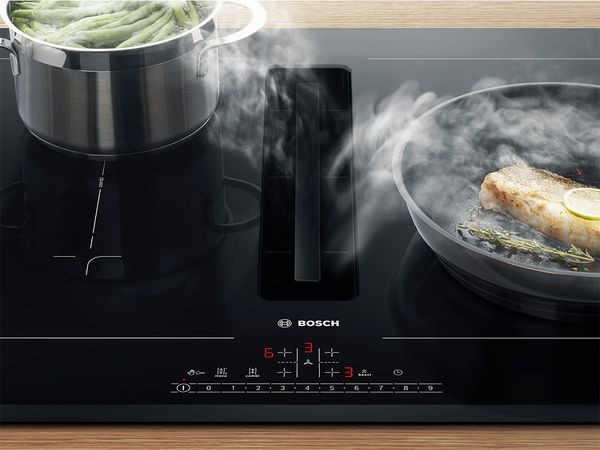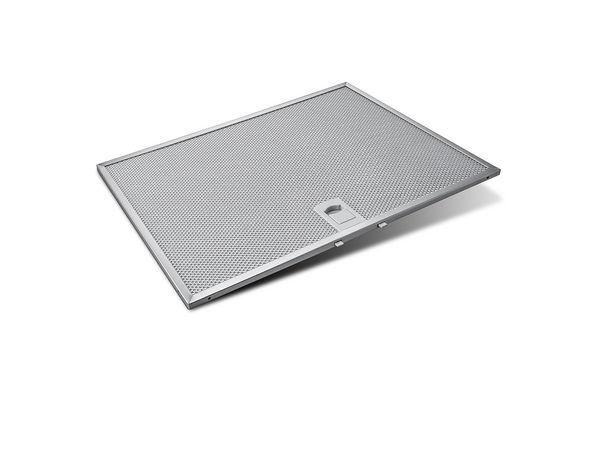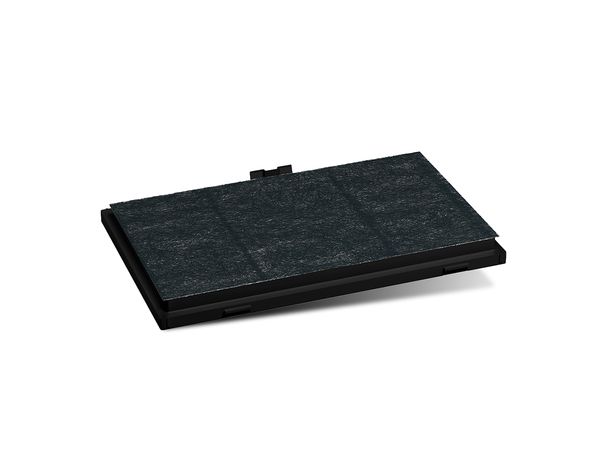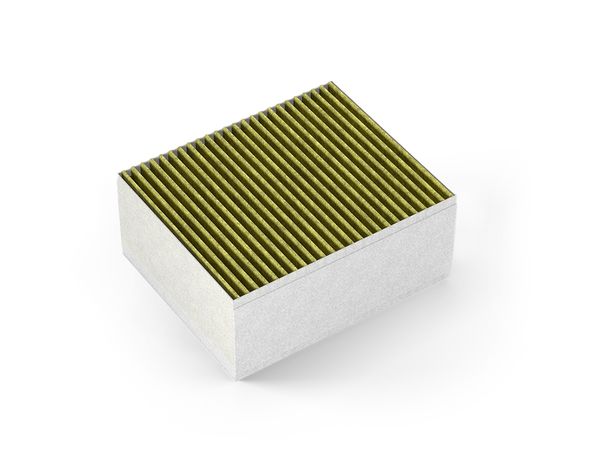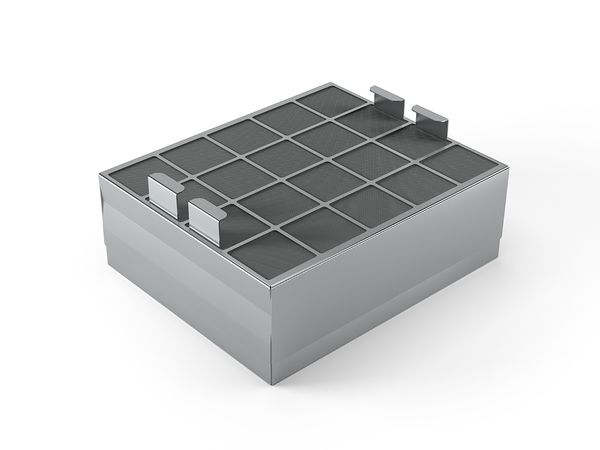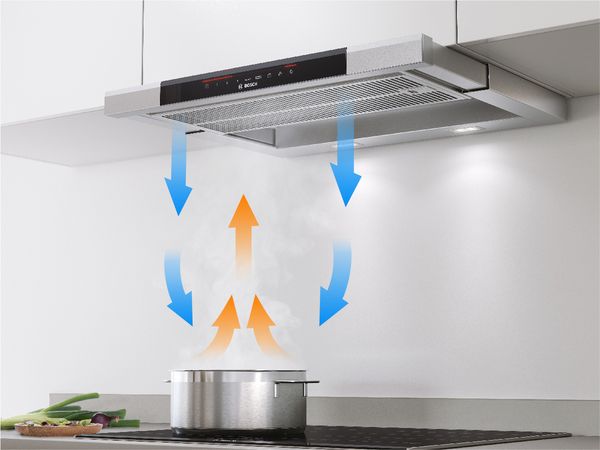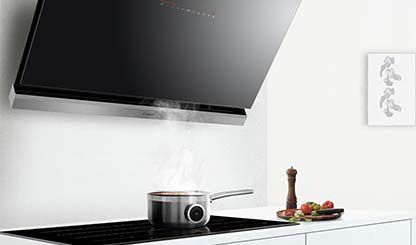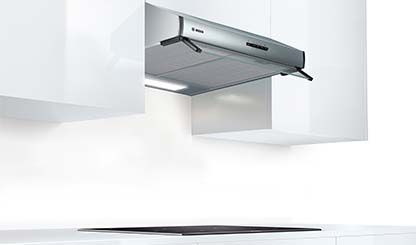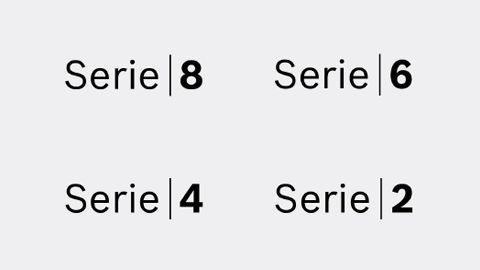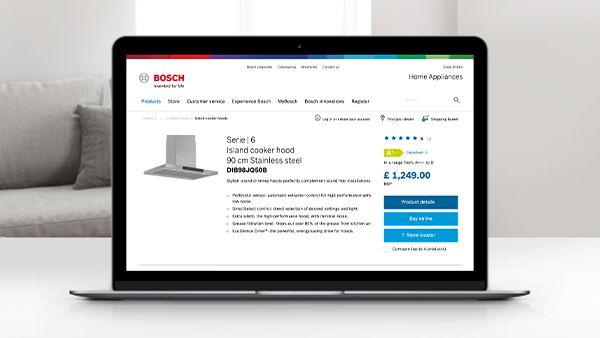7 questions to ask when buying a new cooker hood.
- 1. Which type of cooker hood fits my kitchen?
- 2. What size of cooker hood do I need?
- 3. Would a venting hob work instead?
- 4. Cooker hood noise levels: how quiet should my appliance be?
- 5. What benefits do smart cooker hoods with Home Connect have?
- 6. Which additional features are useful?
- 7. Do I need to switch to a different cooker hood filter?
Which cooker hood is best?
Generally speaking, the best cooker hood for you is the one that fits your kitchen layout, hob size and design preferences.
Depending on where your hob is located – on an island or against a wall – you have different cooker hood designs to choose from. Some common options: canopy cooker hoods, ceiling cooker hoods, integrated cooker hoods, glass cooker hoods. The size is primarily dictated by the width of your hob. Of course, small cooker hoods are available to suit smaller spaces.
In addition to design and size, the noise level of a cooker hood is crucial. While a completely silent cooker hood has yet to be invented, there are many low-noise models to choose from.
This is just a small taste of what to consider. Browse our cooker hood buying guide below for complete answers to your questions.
1. Which type of cooker hood fits my kitchen?
Which cooker hood to buy depends on its placement in your kitchen. More precisely, if your hob is on an island or peninsula, you have different options to choose from than if your hob is against a wall.
Cooker hoods for island hobs.
Cooker hoods for hobs against a wall.
2. What size of cooker hood do I need?
To determine which width of cooker hood to choose, look to your hob. The rule of thumb: to properly remove cooking odours from the kitchen, a cooker hood must be at least as wide as your hob.
60cm cooker hoods: Available as wall-mounted models , integrated models , and venting cooktops .
90cm cooker hoods: Available as wall-mounted models , integrated models , retractable downdraft models , island chimney models , and ceiling models .
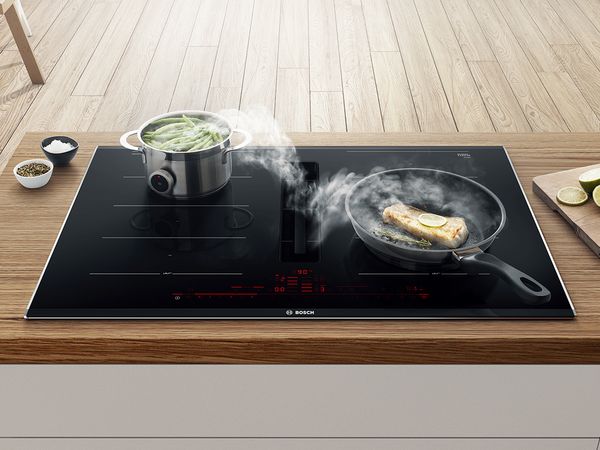
3. Would a venting hob work instead?
If you're also buying a new hob, redesigning your kitchen or simply yearning for a sleek aesthetic, a venting hob is worthy of a closer look, especially if your hob is on an island. A venting hob is an induction or ceramic hob with an integrated hood fan – essentially two appliances in one.
The advantages: No need to buy a separate cooker hood, no obtrusive hood fan blocking your view.
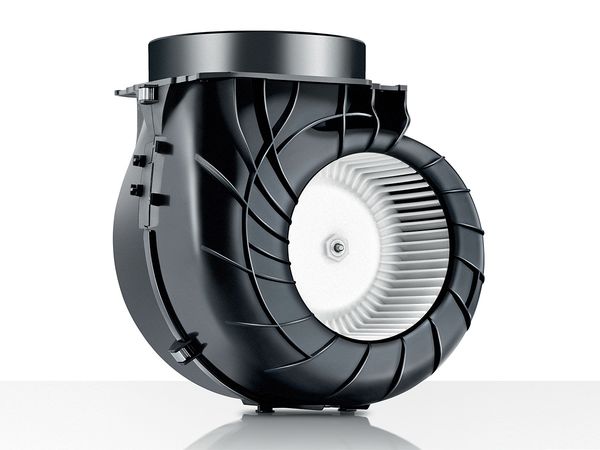
4. Cooker hood noise levels: how quiet should my appliance be?
Because a cooker hood typically runs while you cook next to it, a low-noise model is highly recommendable. Anything above 70 decibels is disturbing and can lead to buyer's regret.
A low-noise cooker hood
Our recirculation inclined hoods emit just 59 decibels, making them the quietest in Europe*. Look to the energy label to see the decibel output of each model.
Pro tip: Even our most powerful cooker hoods are designed to keep noise to a minimum thanks to their aerodynamic design, stable construction and high-quality motor.
Which is our quietest cooker hood to buy? Find out now.
* According to EN 60704-2-13 measured with separately available recirculation filter and chimney.
6. Which additional features are useful?
Innovative features on some of our models help provide a more convenient and comfortable experience with your cooker hood.
Self-regulating fan speed:
The PerfectAir sensor constantly detects the level of odour in the air and adjusts the fan speed automatically. This ensures your kitchen air is always clean and fresh.
Cooktop-based hood control:
Turn on the hob, and your hood turns on automatically – brilliant! Simply synch them via the Home Connect app to control the cooker hood on the hob interface.
Smart Hood Automatic:
Connect your hob and hood via Home Connect, so they speak the same language. The ventilation will automatically switch on and adjust to what's happening on the hob.
7. Do I need to switch to a different cooker hood filter?
Cooker hoods are fitted with two types of filters, a grease filter and an odour filter. A metal grease and particle filter comes standards on all our models. To reduce unpleasant cooking odours in ductless hoods, our cooker hoods come fitted with an active charcoal filter, our CleanAir standard odour filter.
Does your kitchen often smell unpleasant after cooking strong-smelling foods? Our CleanAir Plus odour filter is especially effective at reducing odours. For greater convenience, our LongLife odour filter is especially long lasting. You can upgrade to either anytime.
CleanAir standard odour filter
- Reduces 60-80% of odours
- AntiFish treatment
- 6-12 month lifetime
- Reduces over 90% of odours
- AntiFish treatment
- AntiPollen feature
- 12-18 month lifetime
- Reduces over 80% of odours
- Up to 10 year lifetime
- Regenerate in the oven 3x/year
Pro tip: Using a CleanAir Plus odour filter also noticeably decreases the cooker hood noise level compared to a standard filter.
What are the best cooker hoods?
Which cooker hood is best? The answer depends on your kitchen layout and personal preferences. The best cooker hood brand is also a matter of personal choice. One thing we are certain of: our cooker hoods are German-engineered to please the senses. They look good, effectively reduce odours and come in low-noise models to keep the peace.
How high should a cooker hood be?
It depends on the type of hob you have. For electric hobs, the cooker hood should be installed around 45 to 64cm above the cooktop. A gas hob requires a slightly higher clearance of at least 65cm.
Ductless or extraction hood: what's the difference?
Ductless hoods, also known as recirculating hoods or non-vented hoods, draw in air and clean it using a grease filter and active carbon filter. The cleaned air is released back into the ambient air of the kitchen.
Similarly, extraction hoods draw in air and clean it via a grease filter. Then it's piped straight to an extraction point on the outside of your home.
Pro tip: Most of our cooker hoods can be installed as a ductless hood or an extraction hood, though you might need an adaptation kit.

